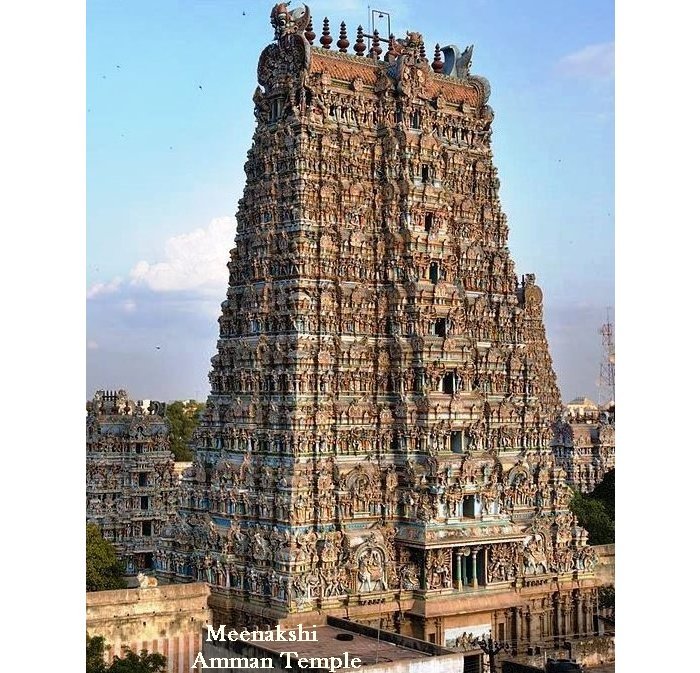Meenakshi Temple Of Madurai Is Among Most Powerful Sacred Sites For Hindu People
A. Sutherland - AncientPages.com - The Dravidian (or Southern-style) is the earlier of the two main styles in the evolution of sacred Hindu architecture.
It is characterized by several architectural masterworks left in the legacy of many ruling dynasties of South India. Their building activities date back from the 7th century onwards. It is worth mentioning that each dynasty developed a distinctive style that survived in extraordinary building designs.
This temple is dedicated to the goddess Meenakshi who is the incarnation of the Hindu goddess Parvati.
In Madurai, one of South India's great temple towns, the Meenakshi Temple is one of the largest and most powerful sacred sites for Hindu people. The temple is dedicated to Meenakshi (an avatar of the Hindu goddess, Parvati) that symbolizes love and fertility.
Legend Of Meenakshi
It is said that Meenakshi emerged out of a 'Yajna' (an avatar of the Hindu god Vishnu in the Bhagavata Purana) as a three-year-old girl. According to a legend found in the Tamil texts, a king named Malayadwaja Pandya, along with his wife Kanchanamali, was unable to conceive a child and thus offered prayers to
Lord Shiva to request him for a son. Instead, a daughter was born out of the fire. She was already three years old and had three breasts. Shiva intervened by saying that the parents should treat her like a son, and when she meets her husband one day, she will lose the third breast, and so it happened later.
The royal pair followed Shiva's advice. The girl grew up, the king crowned her as the successor, and when she met Shiva, his words came true, and she took her true form of Meenakshi. The marriage of Meenakshi and Shiva was a great event, in which participated all the gods, goddesses, and living beings. Vishnu is believed to be the brother of Meenakshi, who – according to Hindu tradition - gives her away to Shiva at the wedding.
Towering Gopurams And Thousands Of Painted Stone Statues
Carved in the Dravidian style of architecture, this ancient Madurai landmark dates back to more than 2500 years and is the oldest in the city. It was built by the Pandyan king, Kulashekarar, in the 6th century B.C. But during the reign of the Madurai Nayak dynasty, the town flourished along with architecture, art, and learning.
Meenakshi Temple (or Meenakshi Amman Temple) has 14 towering gopurams, ranging from 45m to 50m in height, and enclosed by richly carved pillars. The temple has some ancient sections, but the most significant part dates back to the 17th century. The stricture's four gopurams are decorated with a great variety of mythological figures from the Hindu pantheon and can be seen from great distances.
The Meenakshi Temple complex is renowned as one of the temples with doors in each of the four directions for the worshippers to enter. It is also one of the few architectural and, at the same time, religious objects dedicated to a female deity. The ancient Indian builders created thousands of richly painted stone statues displaying the Hindu gods, goddesses, demons, and animals, forming the walls of the Meenakshi Temple's fourteen towers. The towers are not of the same height, but the tallest measures 170 ft (almost 52 m).
A closer look at the carvings at the Meenakshi Temple. Credit: Accesscrawl - CC BY-SA 4.0
Ancient texts say that Tamil Nadu Hindus first built the temple in 600 C.E. before Muslim conquerors destroyed it in the 1300s. Still, after more than two centuries, the sacred site of Madurai was rebuilt during the 16th century.
According to ancient Tamil literature, it was initially built by survivors of the lost continent of Kumari Kandam, a mythical landmass that extended across the Indian Ocean. This mysterious 'land along the mount Meru (Panmalaiyadukkam) submerged during the destruction of Kumari Kandam. It was a vast land stretching from the Himalayas to South Kumari Kandam and the South Pole. Kumari Kandam represents a legendary sunken continent, described in Tamil literature.
Before submerging, Kumari Kandam lay to the south of India, approximately south of present-day town Kanniyakumari, in Tamil Nadu.
Pandiyan Kings of an ancient Tamil dynasty ruled it for 10,000 years and divided into 49 territories. 'Silappadhikaram,' one of the Five Great Epics of Tamil Literature written in 2nd century C.E., confirms this catastrophic event, and another ancient Tamil source gives the list of Pandiyan Kings who ruled the Kumari Kandam.
Written by – A. Sutherland - AncientPages.com Senior Staff Writer
Copyright © AncientPages.com All rights reserved. This material may not be published, broadcast, rewritten or redistributed in whole or part without the express written permission of AncientPages.com
More From Ancient Pages
-
 Unraveling The Mystery Of Ancient ‘False Doorways’
Featured Stories | May 24, 2014
Unraveling The Mystery Of Ancient ‘False Doorways’
Featured Stories | May 24, 2014 -
 3,000-Year-Old Fortress Built By The Mysterious Votadini Tribe Discovered On Top Of Arthur’s Seat
Archaeology | Sep 11, 2020
3,000-Year-Old Fortress Built By The Mysterious Votadini Tribe Discovered On Top Of Arthur’s Seat
Archaeology | Sep 11, 2020 -
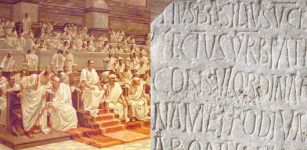 Acta Diurna: World’s First Newspaper Appeared In 131 B.C
Ancient History Facts | Jun 10, 2019
Acta Diurna: World’s First Newspaper Appeared In 131 B.C
Ancient History Facts | Jun 10, 2019 -
 Rare Animal-Shaped Mounds Discovered In Peru
Archaeology | Apr 2, 2012
Rare Animal-Shaped Mounds Discovered In Peru
Archaeology | Apr 2, 2012 -
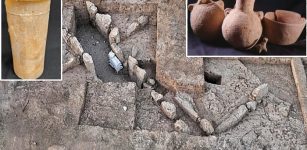 Ancient 5,500-Year-Old Gate Was Discovered Recently At Tell Erani, Near The Kiryat Gat Industrial Zone, Israel
Archaeology | Aug 17, 2023
Ancient 5,500-Year-Old Gate Was Discovered Recently At Tell Erani, Near The Kiryat Gat Industrial Zone, Israel
Archaeology | Aug 17, 2023 -
 Clovis People Invented ‘Fluting’ Ancient Stone Weaponry
Archaeology | Apr 5, 2017
Clovis People Invented ‘Fluting’ Ancient Stone Weaponry
Archaeology | Apr 5, 2017 -
 Kussara – Ancient Lost City Of The Old Hittite Kingdom
Featured Stories | Jul 7, 2021
Kussara – Ancient Lost City Of The Old Hittite Kingdom
Featured Stories | Jul 7, 2021 -
 Unknown Ancient Structures Discovered At Machu Picchu By LIDAR
Archaeology | Mar 29, 2022
Unknown Ancient Structures Discovered At Machu Picchu By LIDAR
Archaeology | Mar 29, 2022 -
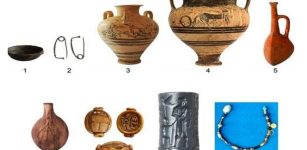 Cyprus’s Copper Deposits Created One Of The Most Important Trade Hubs Of The Bronze Age
Archaeology | Mar 17, 2023
Cyprus’s Copper Deposits Created One Of The Most Important Trade Hubs Of The Bronze Age
Archaeology | Mar 17, 2023 -
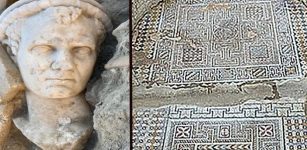 2,000-Year-Old Statue Of Priest’s Head Excavated In Laodicea On The Lycus
Archaeology | Dec 5, 2020
2,000-Year-Old Statue Of Priest’s Head Excavated In Laodicea On The Lycus
Archaeology | Dec 5, 2020 -
 Why We Celebrate Saint Lucy’s Day – The Bringer Of Light And Patron Of The Blind
Ancient Traditions And Customs | Dec 13, 2021
Why We Celebrate Saint Lucy’s Day – The Bringer Of Light And Patron Of The Blind
Ancient Traditions And Customs | Dec 13, 2021 -
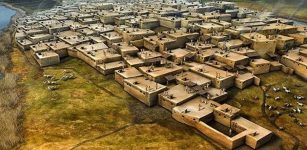 Mysterious Ancient Site Of Çatalhöyük: Remains Of Early Structures May Shed More Light On Its Obscure Past
Archaeology | Apr 11, 2017
Mysterious Ancient Site Of Çatalhöyük: Remains Of Early Structures May Shed More Light On Its Obscure Past
Archaeology | Apr 11, 2017 -
 Weapons Left By Barbarian Tribes Discovered In Polish Forest
Archaeology | Jan 26, 2024
Weapons Left By Barbarian Tribes Discovered In Polish Forest
Archaeology | Jan 26, 2024 -
 Why Were Wampum Belts Important To Native Americans?
Featured Stories | May 10, 2018
Why Were Wampum Belts Important To Native Americans?
Featured Stories | May 10, 2018 -
 2,000-Years-Old Warrior Graves With Iron Swords, Mysterious Square Structures, Unearthed In Bejsce, Poland
Archaeology | Nov 21, 2019
2,000-Years-Old Warrior Graves With Iron Swords, Mysterious Square Structures, Unearthed In Bejsce, Poland
Archaeology | Nov 21, 2019 -
 Mystery Of Feodor Kuzmich – Did Tsar Alexander I Fake His Death?
Featured Stories | Mar 23, 2020
Mystery Of Feodor Kuzmich – Did Tsar Alexander I Fake His Death?
Featured Stories | Mar 23, 2020 -
 Jigai – Suicide Ritual For Wives Of Samurai – Feminine Counterpart Of Seppuku
Ancient History Facts | Feb 24, 2018
Jigai – Suicide Ritual For Wives Of Samurai – Feminine Counterpart Of Seppuku
Ancient History Facts | Feb 24, 2018 -
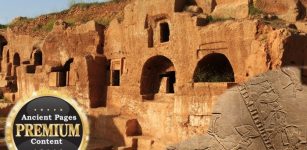 Mysterious Ancient Tomb May Contain Remains Of A Powerful Forgotten Goddess
Civilizations | Aug 30, 2018
Mysterious Ancient Tomb May Contain Remains Of A Powerful Forgotten Goddess
Civilizations | Aug 30, 2018 -
 Courageous Elizabeth Freeman – First African American Slave Who Filed A Freedom Suit
Featured Stories | Oct 24, 2018
Courageous Elizabeth Freeman – First African American Slave Who Filed A Freedom Suit
Featured Stories | Oct 24, 2018 -
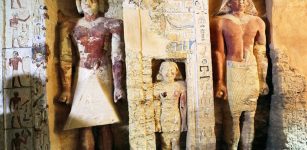 Rare Archaeological Discoveries In The Sacred Animal Necropolis In Saqqara
Archaeology | Apr 26, 2020
Rare Archaeological Discoveries In The Sacred Animal Necropolis In Saqqara
Archaeology | Apr 26, 2020

